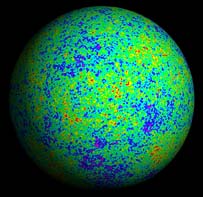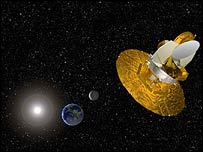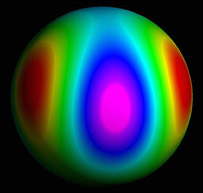Map reveals strange cosmos
The best map yet of the Cosmic
Microwave Background (CMB) Radiation - the so-called echo of the Big
Bang - shows the Universe may not be the same in all directions.
The image has been produced from data collected by the Wilkinson Microwave Anisotropy Probe (Map), which was launched in 2001. "It is a photo of the most distant thing we can see; our best photo yet," said Dr Max Tegmark, of the University of Pennsylvania, US, who processed the image. Dr Tegmark and colleagues present the CMB as a sphere: "The entire observable Universe is inside this sphere, with us at the centre of it." In so doing, the team find something unexpected and so far unexplained in the symmetry of the CMB. Relic radiation In producing the image, Dr Tegmark removed all sources of contaminating foreground radiation leaving only the cosmic background itself.
These effects have to be removed if the CMB is to be studied properly. The radiation that we detect as the CMB comes from a time when the Universe was less than half a million years old; from the so-called recombination era when hydrogen atoms formed in the cooling, expanding fireball of the Big Bang. It was a time when the stars and galaxies had yet to form. There was only gas. In general, the relic radiation from these clouds is almost isotropic - the same in all directions. 'Glowing wall' For decades, astronomers knew there must be secrets about the Universe in the CMB, if only they could observe it at a high enough sensitivity.
The variations in the CMB contain information about the formation of the galaxies, the composition of the Universe and its fate. Having produced the cleanest map of the CMB yet, Dr Tegmark displayed it in an unusual manner. Instead of a flat projection on a computer screen, he showed the data as ripples on a sphere - "after all the CMB comes from a sphere", he says. "Space continues outside the sphere but this opaque glowing wall of hydrogen plasma hides it from our view. If we could only see another 380,000 light-years we would be able to see the beginning of the Universe," he told BBC News Online. Looking for evidence And he added: "We found something very bizarre; there is some extra, so far unexplained structure in the CMB. "We had expected that the microwave background would be truly isotropic, with no preferred direction in space but that may not be the case." Looking at the symmetry of the CMB - measures technically called its octopole and quadrupole components - the researchers uncovered a curious pattern. They had expected to see no pattern at all but what they saw was anything but random. "The octopole and quadrupole components are arranged in a straight line across the sky, along a kind of cosmic equator. That's weird. "We don't think this is due to foreground contamination," Dr Tegmark said. "It could be telling us something about the shape of space on the largest scales. We did not expect this and we cannot yet explain it." It may mean that the CMB is clumpier in some directions than others. Some theories of the structure of the Universe predict this but observational evidence to support it would be a major discovery. copied from http://news.bbc.co.uk/2/hi/science/nature/2814947.stm |


